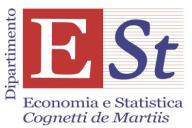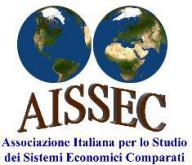20 | DECEMBER 2021
Edited by Luca Bortolotti, University of Turin and OEET
In the last decades, with the emergence of Global Value Chains (GVCs), the tasks and functions for the production of goods and services have become increasingly specialized and fragmented accross different countries. On the one hand, this phenomenon, as well as macro-regional networks, has played a role in boosting growth in many developing and emerging economies. Indeed, while building whole industries from scratch can be hardly achieved by developing countries, entering in specific phases of production is much easier. On the other hand, GVCs can trigger unbalances, inequality, marginalization of the working class (particularly in high income countries) and environmental degradation, creating a context more vulnerable to climate crisis and shocks in international prices and logistics. Moreover, the integration of developing countries in GVCs is often limited and, when it occurs, reserves the larger share of value added to high-income countries.
The importance of GVCs poses new challenges also for the academic research, both at theoretical and empirical level. The understanding about whether and how participating in GVCs can promote economic development is crucial for emerging economies. But the micro-level data on firms’ international operations along the value chain remains largely beyond the reach of national accounts and statistics which are not designed to capture this kind on information. Analysis relies on data on trade and foreign direct investments’ flows, input-output datasets, or on micro level data, but in all cases, scholars dealing with GVC, have to address important methodological issues in their analyses.
By Andrea Coveri[*] and Antonello Zanfei[†]
The rise of global value chains (GVCs) prompted firms to increasingly specialize in specific value chain functions, the latter being conceived as the full set of business activities – from those concerning the conception of goods to the ones relating to their fabrication and commercialization – carried out to develop and bring a product to market (Feenstra, 1998; Sturgeon and Gereffi, 2009). The result has been the emergence of an ever finer international division of labour that occurs mainly at the level of individual production stages within sectors, also called “tasks” (Grossman and Rossi-Hansberg, 2008).
This transformation, together with the increasingly uneven distribution of value across actors performing different business activities, has been often associated with the “smile curve” hypothesis (Shih, 1996; Mudambi, 2008).
However, well-suited empirical analyses on the modern functional specialization of economies and tests of the predictions deriving from the smile curve are still limited in extant literature. The present work takes a step forward in this direction. By focusing on the functional specialization in terms of inward FDIs of more than 100 countries from 2003 to 2018, we provide a novel and systematic test of the “smile curve” on a global scale. Our findings shed new light on global economic asymmetries and the development prospects of emerging and developing economies in the era of GVCs. [1]
By Ivan Savin[*]
The model of replicator dynamics as an evolutionary theory of competition between firms in economics is widely used. I describe how to test this model based on empirical data, as well as the advantages and disadvantages of these tests. Furthermore, I describe ways on how to improve the model of replicator dynamics taking into account global value chains and using the world input-output database, which helps to obtain more thorough and accurate results.[1]
By Nora Aboushady[*] and Chahir Zaki[§]
An increasing part of today’s international trade takes the form of Global Value Chains (GVCs). According to the estimations of the OECD, about 70% of international trade involves GVCs, as raw materials, intermediate goods, and services cross the borders several times to be incorporated into the final product.[1] GVC activities are also affected by the firm’s decision to outsource parts of the production process or invest in other countries where there is a comparative advantage related to costs or factor endowments. GVCs represent therefore a promising opportunity for developing countries to find a place in the international market by producing and exporting along these chains, to attract foreign investments if their markets are competitive, and to harmonize production standards and acquire international certifications. This will help them increase and diversify their exports and export destinations.
The determinants of one country’s participation in GVCs is therefore not only related to its production and export structure, but also to its overall investment climate and trade policy in place (Dovis and Zaki, 2020). The quality of institutions and the prevalence of informal practices and corruption also affect the overall transparency and competitiveness of markets and firms’ potential engagement in GVCs.
The Egyptian case is of particular interest. In fact, the country’s integration in GVCs remains relatively limited. Despite serious investment and trade policy reforms, Egypt -as the rest of the MENA region- continues to perform weakly in international trade. Compared to other regions, the MENA region has a modest share of firms that are large and/or productive enough to engage in GVCs. In this article, we explore the reasons behind Egypt’s weak GVC integration by focusing on trade policy and political connections and propose policy recommendations to overcome these obstacles.
Our activities
-
11th OEET Workshop Programme
Global Trade Shocks and Geopolitical Uncertainty: Implications for Food Security in Emerging...









